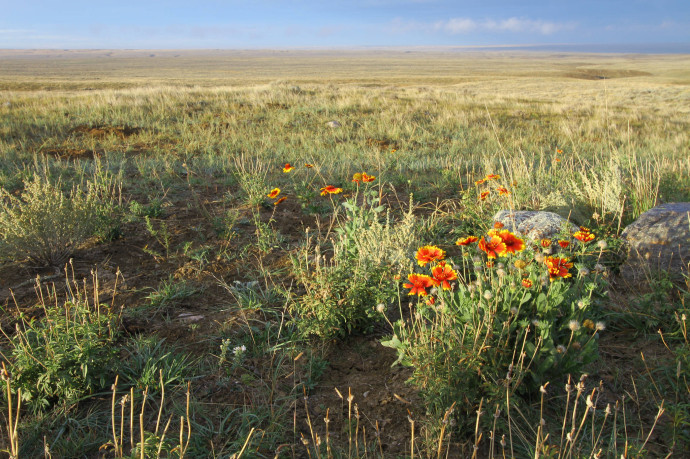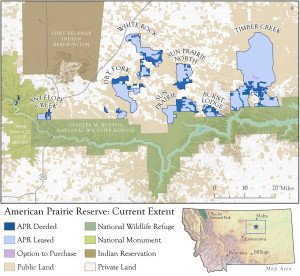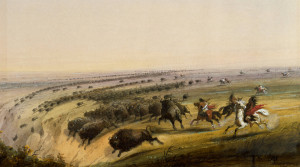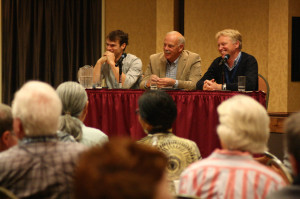Between 25 September and 4 October 2014, Frans Schepers and Wouter Helmer visited Wyoming and Montana in the United States, where they were invited to speak about Rewilding Europe at the 2014 Annual Gathering of the American Prairie Reserve. This is the second out of a series of blogs, presenting some of the impressions of their visit.
(Read the first part here.)

After reading ‘Rewilding the West: Restoration in a Prairie Landscape’ from Richard Manning (2011) we became more and more inspired to visit Montana. This book describes in an intriguing way how Europeans colonized this part of the ‘New World’, and how an area teeming with wildlife – millions of bison, pronghorn, elk, white-tailed deer and the associated carnivores such as wolf, grizzly bear and cougar – was transformed into an intensive cattle grazing area. How symbolic and inspiring for us as Europeans to behold the rewilding of this area nowadays and share experiences with our colleagues in North America!
It was in Amsterdam where our first meeting with Dick Dolan, one of the Managing Directors of the American Prairie Reserve, took place. Right away we discovered a number of interesting lessons to share, although the context in Europe is of course quite different compared to North America. Rewilding Europe has set itself a goal to connect with and learn from ‘peer initiatives’ in different continents. So far, we have mainly been linking with African experiences (e.g. on community conservancies, wildlife based tourism, enterprise and financial models) but we are also exploring others – including Australia and North America.
Serengeti of North America
 The American Prairie Reserve (APR) is a groundbreaking initiative to restore this unique ecosystem – in size and potential comparable with the vast grassland ecosystems in Kazakhstan, Mongolia and Patagonia. The American Prairie Reserve started in 2004 and is spearheading a unique effort to create the largest wildlife reserve in the continental United States by linking together more than three million acres (some 1,2 million hectares) of private and public land on north central Montana’s legendary Great Plains. This should become a spectacular wildlife reserve that rivals the Serengeti. The core area is meant to be connected with Fort Belknap Indian Reservation on the western border, while ‘soft’ borders are being created with the surrounding cattle farms – to allow for wildlife dispersal and connectivity. APR currently owns and/or leases more than 305,000 acres of deeded and public land. Additionally, APR has purchased historically held grazing privileges on more than 63,000 acres in the adjoining Charles M. Russell National Wildlife Refuge.
The American Prairie Reserve (APR) is a groundbreaking initiative to restore this unique ecosystem – in size and potential comparable with the vast grassland ecosystems in Kazakhstan, Mongolia and Patagonia. The American Prairie Reserve started in 2004 and is spearheading a unique effort to create the largest wildlife reserve in the continental United States by linking together more than three million acres (some 1,2 million hectares) of private and public land on north central Montana’s legendary Great Plains. This should become a spectacular wildlife reserve that rivals the Serengeti. The core area is meant to be connected with Fort Belknap Indian Reservation on the western border, while ‘soft’ borders are being created with the surrounding cattle farms – to allow for wildlife dispersal and connectivity. APR currently owns and/or leases more than 305,000 acres of deeded and public land. Additionally, APR has purchased historically held grazing privileges on more than 63,000 acres in the adjoining Charles M. Russell National Wildlife Refuge.
Bison back after more than 140 years
In 2005, the first 16 American bison from Alberta, Canada were reintroduced in the area – after an absence of more than 140 years. More introductions followed in consequent years and taking into account annual growth, the herd is currently at 440 animals, while an additional expected number of 130 calves will be born in 2015. If the reserve and the bison population continues to grow as projected, it is expected that a population of some 12,000 animals will be present in 2029. So far, some 45 miles of fences have been removed to allow the bison to roam in a large area. The current area is fenced out with wildlife-friendly fences.

Like the European bison, the American bison was nearly extinct due to overharvesting, excessive hunting and habitat loss. In 1889, when they had reached their lowest level, there were only 256 bison in captivity, 200 protected by the United States Government in the Yellowstone Park, and 635 running wild. Approximately 30,000 bison currently exist on public lands, which includes environmental and government preserves.According to the IUCN, approximately 15,000 bison are considered wild, free-range bison not primarily confined by fencing. The largest free roaming populations living in Yellowstone National Park (4,600 in 2014) and Badlands National Park, South Dakota (650 in 2014).
Some impressions of the reserve
During a 3-day visit from 29 September to 2 October, we explore the prairie reserve. We enter the area by crossing the Missouri river near Upper Missouri River Breaks National Monument. Heading east we stop at Slippery Ann, where we watch spectacular elk rut at close range. In the Charles Russel National Wildlife Refuge, bordering the American Prairie Reserve in the south, some 10,000 elk live again after reintroduction around the 1950s – a successful comeback indeed, now also starting to attract large carnivores like wolf and cougar.
At dark, we arrive at the lovely and tastefully designed ‘Kestrel Camp’, which built is based on the ‘yurt’ concept of the Mongolian steppe. It is a beautiful spot in the middle of the reserve, from where one can explore the surroundings.

The next two days we visit a number of interesting places, such as Sun Prairie (currently the core part of the reserve), the proposed boundaries of the reserve, APR Headquarters with the new Enrico Education Centre under construction and a ‘Buffalo Cliff’, near Telegraph Creek. Here, many bison lost their lives when massively hunted – contributing to their extinction. During our visit we see small herds or solitary pronghorn antelope, colonies of prairie dogs, hunting prairie falcon, white-tailed deer, sharp-tailed grouse, burrowing owl, bald eagle, sandhill crane, sage grouse, a herd of 350 bison – with some 70 calves born this year – and howling coyotes during the night in camp. A wonderful and inspiring experience to see wild nature and species bouncing back when allowed to. This is even not the best part of the season – and this place has so much more potential for rewilding!
What do Rewilding Europe and APR have in common and what can we learn?
In Europe, we are pioneering and defining ‘rewilding’ in our own context – as there are no blueprints that can simply be copied from anywhere else. With 47 countries (of which 28 in the EU) Europe nearly has a similar number of states as the 48 ‘lower states’ in the US; however in Europe all these countries have their own cultural, political, socio-economic and conservation context.
Both Rewilding Europe and APR are pioneering ‘rewilding’ – a progressive way of doing conservation – that alone already provides a number of interesting issues and experiences to share at a conceptual, strategic and practical level.
Apart from the pioneering character and the challenges this brings, we also find similarities linked to our business approach, active support of wildlife comeback, zonation principles and allowing a variety of natural processes to take their course in different ecosystems. Differences are also obvious: APR is now working for 10 years on the ground (Rewilding Europe only 4 years), the proposed sheer size of APR (compared to each of our rewilding areas), the large-scale purchase and lease of land (not a core part of our strategy), the fact that APR is working in one place (Rewilding Europe now in 7 different places) and the central role of local communities in Rewilding Europe are just a few examples here.
The Annual Gathering 2014 and follow up

On 4 October, some 150 guests from all across the United States attended the Annual Gathering in Bozeman. Each year, American Prairie Reserve invites leading conservation initiatives from around the world. Our presentation was well received. Most of the participants had never heard of Rewilding Europe and were excited to learn about our initiative and our work so far. Apart from the presentation and panel discussions, we had numerous talks with individual guests who wanted to learn more.
While exploring communalities further, APR and Rewilding Europe have agreed to start exchanging experiences in more detail during the year to come. Among others this would cover:
- Bringing back the bison as a key species in both North America and Europe, both strategically, by setting up practical experiences and mobilizing large audiences for supporting this,
- Sharing concepts and mechanisms developed by Rewilding Europe that could be interesting for APR, such as the European Wildlife Bank and Rewilding Europe Capital,
- The other way round: sharing concepts and mechanisms that could be interesting for RE, such as the Wild Sky beef initiative and the APR monitoring system (‘Frees Scale’),
- Issues around ‘soft boundaries’ and ‘co-existence’ with large carnivores and large herbivores, including zoning, fencing and others,
- Sharing and mutual support towards fundraising possibilities both in Europe and United States.
We hope to welcome a delegation of APR in Europe in 2015 or 2016, to have a look at our work in Europe so far and further strengthen the working relationship and learning experiences.
